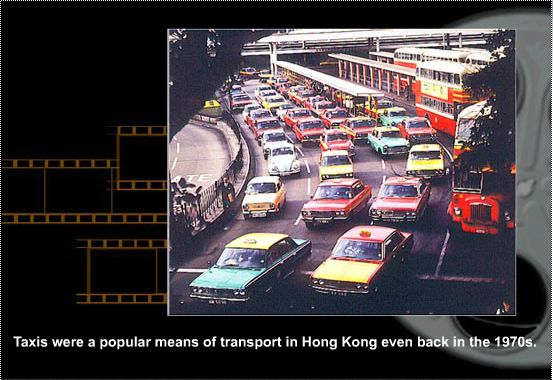| 60's |
 |
 |
In the 1960s, Hong Kong had five major transport companies and at the Jordan Road ferry terminal in Kowloon an impression can be gained of their variety. Seen here are the vehicular and passenger ferries, double-decker and single-decker buses, taxi cars and taxi vans. Apart from serving points in the city areas, the passenger ferries also operate to the outlying islands. |
 |
The traffic policeman on his 'pagoda' directing traffic in the 1960s can be seen as the most primitive form of area traffic control. |
 |
A ferry bustles towards the busy waterfront. |
 |
A typical street scene in the 1960s, showing Hong Kong's distinctive red double-decker buses with a stream of cars. |
 |
An aerial view of the open carparks on the waterfront in Central District. |
| |
|
| 70's |
 |
 |
The San Po Kong interchange, one of a number of major road projects completed in the 1970s to ease congestion on Hong Kong's roads. |
 |
Taxis were a popular means of transport in Hong Kong even back in the 1970s. |
 |
There were almost 4,000 public light buses plying for hire in most areas of Hong Kong Island, Kowloon and the New Territories in 1970s. |
 |
Hong Kong Tramways operated an electric tramway service on Hong Kong Island at a frequency of one every 25 seconds within city centre in the 1970s. |
 |
Road networks were built in the late 70s to pave way for the building of housing and community amenities at the Sha Tin New Town. |
| |
|
| 80's |
 |
 |
A typical scene of busy traffic at noon time in Queensway, Hong Kong Island. |
 |
The Light Rail Transit system linking Yuen Long and Tuen Mun was a new transport service in the late 1980s. |
 |
Elevated walkways give pedestrians easy access to the wide choice of land and sea transport available on the waterfront in Central District. |
 |
The Eastern Harbour Crossing, a vital new road link between Hong Kong Island and eastern Kowloon, was opened to traffic in September 1989. Shown here is the road complex at Quarry Bay on the Hong Kong side. |
 |
The Peak Trams underwent an extensive renovation of the century-old system in 1989. In elegant burgundy and gold livery, the new Peak Tram cars are bigger, faster and more comfortable than their predecessors. |
 |
The old fishing junk and the new ferry vessel plying the Victoria Harbour. |
| |
|
| 90's |
 |
 |
The double-deck Lantau Link comprises the Tsing Ma Bridge and the Kap Shui Mun Bridge which are the world's longest suspension bridge and cable-stayed bridge respectively carrying both and rail traffic, as well as the Ma Wan Viaduct. |
 |
The Lantau Link was opened to traffic in May 1997 to provide the link to the new sophisticated traffic control and surveillance system enabling very effective control and management. |
 |
Airport Railway commenced operation in July 1998 to provide a fast and high quality transport service to the new airport at Chek Lap Kok. |
 |
The franchise of China Motor Bus (CMB) expired on 31 August 1998 marking the end of 65 years of service. The New World First Bus was granted a new franchise for 88 bus routes in place of CMB. |
 |
The Western Habour Crossing, the third cross-harbour tunnel linking Hong Kong Island and western Kowloon, was opened in April 1997 to further ease cross-harbour traffic. It is one of the items in the Airport Core Project. |
 |
The Route 3 (Country Park Section), which includes Tai Lam Tunnel and the Yuen Long Approach Road, and the Ting Kau Bridge, connect the northwest New Territories with the urban area. Both opened in May 1998, they provide a fast route to the new airport as well as an alternative route to the congested Tuen Mun Road. |





















